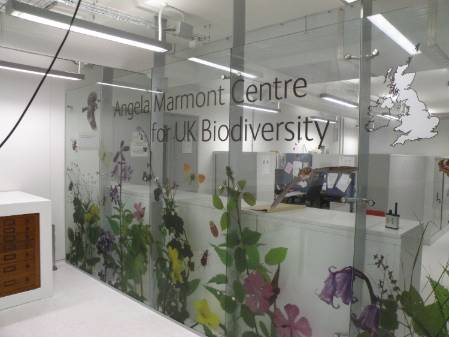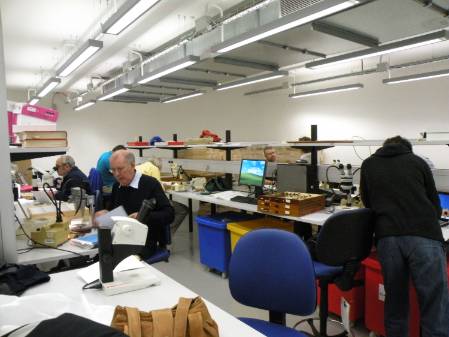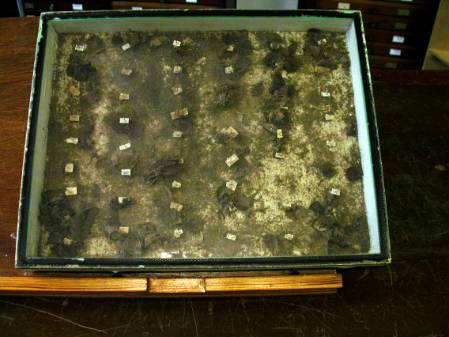It is a Tuesday morning and I have a stinking cold. I have this now as yesterday I spent the day recovering from the last three weeks and so my body thought it was time to give me all the infections that had been going around the department previously which it had been storing up for a special occasion!
The melt down has occurred through a culmination of the collection moving, a synoptic collection being created and the hosting of the Dipterists Forum at the weekend based in the New Darwin Centre. However it was fab. For months now I had been organising catering, room booking, way-signs etc etc with the rest of the team being enlisted to make labels, print forms, lug equipment around etc. And yet still on Saturday morning when everyone turned up there were still things that went wrong (not helped by the tube shutting both the district and circle lines!!! ). I guess that had to be expected.
But we had four fabulous talks on Saturday morning to an audience of just under 60 in the new Neil Chalmers Lecture theatre. First up was Chris Thompson (eminent American Dipterologist) who talked about the state of Diptera identification from it's beginnings to now. It is always lovely to hear someone from the States to say how brilliant the UK is about certain things, one of which is level of which our fauna is studied and the passion of the wider community for recording etc. This is seen with things like the hoverfly recording scheme. Looking at a world map showing spots where records had been added to GBIF etc. The UK is absolutely covered with the rest of the world showing a distinct lack of sites (apart from Chris's backyard!).
Next was the fabulous Geoff Hancock (Glasgow Museum - all the more fabulous for stepping in at late notice) who gave a talk on specific craneflies that you could identify through the pupal cases that they left behind. This is a secondary character that enables ecologists to monitor populations without killing any of the specimens so are crucial when dealing with rare and/or endangered species.
After coffee we started with Graham Rotheray (Edinburgh Museum) who discussed higher Dipteran larvae, specifically their feeding apparatus. Some excellent photographs showing the very reduced structures associated with the heads. And finally Stuart Ball who gave a talk on recent work on Hoverflies. Lot's of fun with modelling of the data! We dragged everyone upstairs to our lovely new common room giving a few people vertigo on the way for lunch! The afternoon resumed with the AGM followed by individual recording groups detailing the years activity. Some lovely photographs supplied by Judy Webb for Peter Chandlers Mycetophila talk.
Then off to the pub! followed by a meal. Brilliant
The next day a fair number of people returned to the museum for a tour and then to play in the collections! The tour started with Hannah Cornish giving an introduction and show round of the AMC for UK biodiversity.
They were impressed by the space and hopefully you will see some workshops on Diptera identification being run from there soon. Next was the UK Diptera synoptic collection. This collection was finished on Friday at 4.15pm!! Nigel Wyatt, Kim G, Hannah and I have worked solidly over the last two weeks to get the collection in. I was a walking zombie often leaving past nine at night. One night even my Mum helped although she did spend a fair amount of time laughing at all the species names. But against much adversity it was completed (albeit the slide and the ones that we had no pads for! they turned up this morning!) But by the time the tour started 250 drawers were in the synoptic collection and being looked over by the amateur specialists. It was such a lovely site.
We then carried up to see the spirit collection (and try and presuade them that they wanted to help sort material ) followed by a look in the imaging lab. Finally we showed them the cocoon ends and the main British and World collection in their new homes. They loved it! People split off and either corrected the synoptic collection, retrieved data off labels, used the collection to aid in identifications, or generally just nosed around 'ohhing' and 'ahhing' every now and again. People donated material and there were many offers of future donations to fill the main gaps in the collection
We have decided to hold another session similar to this in February before the sampling kicks in again to provide opportunities for the group to cross check material etc. My highlights were the hedgehog fly and i have to say I was very impressed with some of the Tachinids (not a group i usually look at). Stuart Balls comment of having walk through genitalia was my favourite of the day











